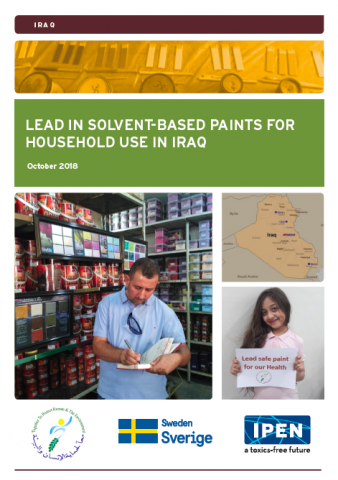Study Shows Many Paints Sold in Iraq Contain Lead

Baghdad, Iraq. The first study on lead content in Iraqi paints for home use was released today by Together to Protect Human & the Environment Association (Together) and IPEN, with facilitation of the Ministry of Health & Environment. It reveals that more than 70 percent of the analyzed paint brands sold one or more paint that contained total lead concentrations exceeding 90 parts per million (ppm)—the maximum allowed limit in e.g., the United States, India and Kenya, and also the limit recommended by the UN Environment Programme for all paint. Furthermore, a yellow Al-Marjan Gloss Enamel Paint contained the highest amount of lead at 110,000 ppm.
“The exposure to lead, even at low levels, affects a child’s brain development leading to lasting effects throughout life such as lower IQ, poorer performance in school, and impulsive and violent behavior,” said Saadia Hassoon, Chairman, Together. “Such effects impacts work performance in the long term, so there is no better time to act but now. Otherwise, we will imperil our children’s intellectual growth and consequently reduce Iraq’s future intellectual capacity and economic success even though safe and effective alternatives are already in use and widely available. It is therefore important to eliminate this dangerous source of lead exposure to young children.”
“Lead paint is a widespread source of childhood lead poisoning and there are no known safe levels of exposure,” said Dr. Sara Brosché, Global Lead Paint Elimination Campaign Manager, IPEN. “Children are the most susceptible, ingesting lead-contaminated dust from deteriorating lead paint through typical hand-to-mouth behavior. We highly encourage the government to enact policies that will ban the production, import and use of lead in all paint, together with effective compliance monitoring mechanisms.”
From December 2017 to January 2018, Together purchased a total of 38 cans of solvent-based paint intended for home use representing 15 brands and produced by 11 manufacturers from various stores in Baghdad, Iraq. Samples from these paints were analyzed by an accredited laboratory in the USA for total lead content.
Key findings from the report, Lead in Solvent-Based Paints for Home Use in Iraq, include:
- Nearly half (42 percent) of the solvent-based paints contained lead concentrations above 90 ppm. Moreover, five percent of the paints contained dangerously high lead concentrations above 10,000 ppm.
- The highest lead concentration detected was 110,000 ppm in a yellow Al-Marjan Gloss Enamel Paint manufactured in Iraq.
- About three-fourths (73 percent) of the paint brands in the study sold at least one paint with lead concentrations above 90 ppm; thirteen percent of paint brands sold at least one paint with dangerously high lead concentrations greater than 10,000 ppm.
- Yellow paints were the most hazardous with 17 percent containing lead concentrations greater than 10,000 ppm.
- Most paint can labels did not carry meaningful information about lead content or the hazards of lead paint.
There is currently no legally-binding regulation on lead paint in Iraq. There is an existing 90 ppm standard limit, but only covers acrylic paints. Acrylic paints are outside the scope of the study since these paints are less likely to contain lead unlike solvent-based paints. Most highly industrial countries adopted laws or regulations to control the lead content of decorative paints—the paints used on the interiors and exteriors of homes, schools, and other child-occupied facilities—beginning in the 1970s and 1980s. In Asia and Africa, many countries have adopted new strong regulatory controls the past ten years.
The World Health Organization (WHO) recognizes lead paint as a major source of “lead-caused mental retardation,” a disease WHO identifies as one of the top ten diseases whose health burden among children was due to modifiable environmental factors. WHO further states that “there is no known level of lead exposure that is considered safe.”[1]
Key recommendations made in the report include:
- Government: For the Ministry of Environment and Health to immediately draft a regulation that will ban the manufacture, import, export, distribution, sale and use of all paints that contain total lead concentrations exceeding 90 ppm. For the Ministry of Commerce to tighten import control procedures by requesting necessary documents to confirm that paints imported into the country do not contain added lead.
- Industry: Stop the use of lead-based pigments, driers, and substances in paint formulations, and shift to non-hazardous alternatives.
- Consumers: Purchase and use paints with no added lead, especially in places frequently used by children such as homes, schools, day care centers, parks and playgrounds, and demand full disclosure of a paint product’s content.
About IPEN
IPEN is a global non-government organization (NGO) with participating organizations in more than 100 countries working for a toxics free future. It has conducted studies of lead in paint in nearly 60 countries and is a member of the Global Alliance to Eliminate Lead Paint Advisory Group. For information, visit www.ipen.org.
About Together
Together is a non-governmental organization working all over Iraq, focusing on building peaceful society and protecting environment through improving legislation and changing behaviors of individuals and the relevant laws. Together is a member in many international networks such as IPEN, GEF-CSO Network, Housing & Land Rights Network/Habitat International Coalition, Earth Day Network, Community Anti-Drug Coalitions of America (CADCA), and Arab Network for Environment & Development. Together got funds from many International organizations to do many projects (e.g., USAID, US EMBASSY, CIDA, CADCA, UNESCO, UNFPA, RI, USIP, FIDA, American University-Global Peace Center, and IPEN). IPEN supported Together to implement this study. For more information, visit www.togetherecho.org.
For More Information:
Saadiyah F. Hassoon, Together to Protect Human & the Environment Association, +964 750 736 1549, saadiaalsalhy@gmail.com
Sara Brosché, IPEN, +46 31 7995900, sarabrosche@ipen.org
Jeiel Guarino, IPEN, +46 31 7995930, jeielguarino@ipen.org
[1] World Health Organization. Lead poisoning and health (2015). Available from: http://www.who.int/mediacentre/factsheets/fs379/en/.
